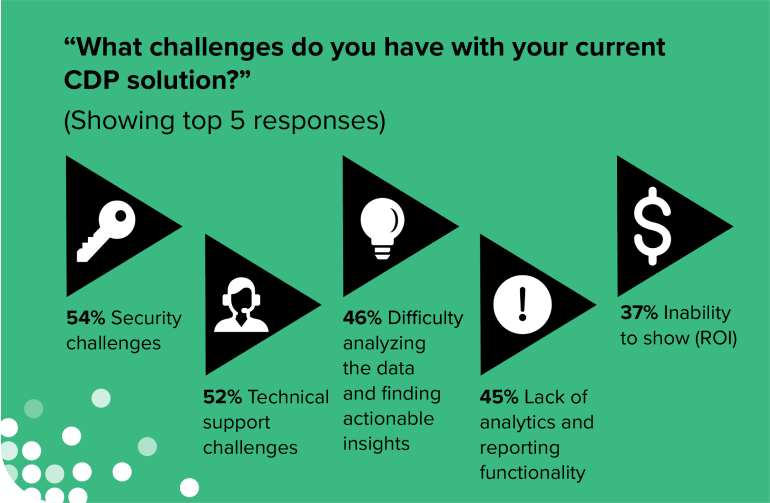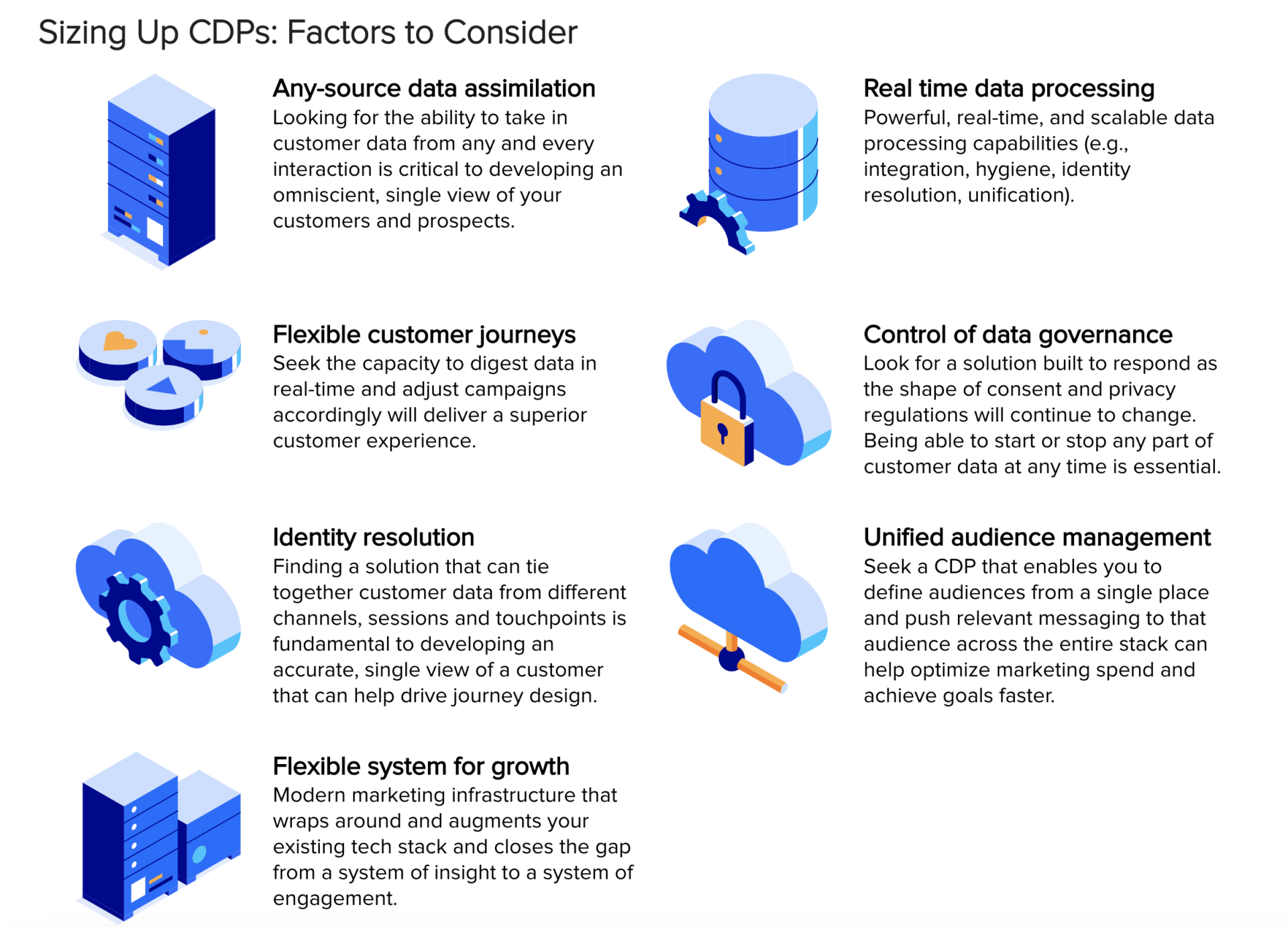TRENDS & TOPICS: CDPs
Marketer's Guide to Customer Data Platforms
Did you know...
- Most brands are dissatisfied with their CDP solutions (are you?)
- Choosing the right CDP can reduce the total cost of your mar-tech stack?
- The most critical differentiator among today’s CDPs is not tech-related
Data is the lifeblood of every modern business.
There are massive amounts of customer data coming at marketers constantly, from everywhere, including digital properties, call centers, apps, in-store transactions and more.
Data can also be terrifying.
More than ever, marketing organizations are under pressure to take all the data their expensive tech stack can serve up and use it to architect an outstanding customer experience—and never stop improving. No pressure!
This non-stop data deluge can be extremely overwhelming and makes it hard to know what to do. Ever-changing regulations around what consumer data you can collect, how you’re allowed to collect it, and how you can use it don't make things any easier.
Customer Data Platforms (CDPs) are meant to aggregate multi-source consumer data and enable meaningful marketing activities in real time. A well-designed CDP can improve engagement quality, increase conversions, and enhance (rather than complicate) your existing tech stack.
Customer Data Platforms: What You Need to Know about CDPs
The Perils of Choosing a CDP
As sources of consumer data multiply exponentially, the demand intensifies for cost-effective solutions that aggregate and organize data into a single, centralized view. In this circumstance the value proposition of a CDP should be very clear. Truly bespoke experiences to prospects and customers should be no problem when data is this abundant and accessible. But across the board and in almost all industries, there’s still a problem with CDPs underperforming or worse, not fulfilling their business purpose.
In a Forrester Consulting survey commissioned by Zeta, 45% of respondents said their current CDP has underperformed against business expectations. It’s harder than it should be to find a CDP offering that can reliably deliver on the coveted single customer view, intuitive reporting, content personalization, segmentation, data orchestration and native execution. The Forrester study further reveals that only 10% of respondents said their CDPs meet all their current needs, and only 1% felt their CDP is poised to answer future requirements.
Marketers are Struggling with Their CDPs

These stark numbers suggest what’s actually happening on the ground: Prospective consumers are routinely sent messages that are not right for where they are in their customer journey. Or worse, messages that are not relevant to them at all. Sound familiar? Today customers have exceedingly high standards. They simply won’t stay where they’re not engaged.
Why Marketers Choose Zeta CDP+ Hear from Zeta’s CTO Christian Monberg.
Close the Gap Between Data Accessibility and Usability
First-party data—the data you collect about your own customers—is fully usable if and only if it is properly integrated and maintained. Don’t expect to achieve full usability by cleaning up database tables using one-time processes, no matter how many of those processes you employ, or how frequently. It requires enforcing rigor in a system of record with integrated, repeatable, ongoing data services.
New customer data is onboarded all the time, which means deleting and merging duplicate data should be a constant value whenever new data is being integrated. It’s one of the primary drivers when companies consider adopting a CDP—centralizing customer data and automating the rigorous requirements associated with data unification and hygiene. You want your customer data to be accurate and actionable at any given moment, not just the day after your last merge process.
Engaging third-party data is an effective way to enrich your first-party data and ultimately expand your understanding of customer and prospects. But again, if your own data isn’t integrated properly with external data, it generates little value. While we all wish a few APIs would be enough to integrate everything, it’s not that simple. Integrating data requires bespoke attention and expertise. Without it, it’s not likely you’ll get actionable guidance from your CDP and the reason will be hard to pinpoint. In many cases, clean data integration is undervalued.
The Business Case for Data Usability
Find out why customer data management doesn’t stop at accessibility.

Lost Time Is Missed Revenue Growth
Where return on investment (ROI) measures the financial success of an investment, time to value (TTV) measures how long until you can get your investment up and running so it delivers on the reasons you bought it.
If you’re able to use your marketing software faster than your competitors, it can make a massive and durable difference in getting and keeping customers. The shorter the time to value, the faster you’ll see revenue growth.
How to Recognize and Reduce Tech Debt in 2022
Next-Generation CDPs Transcend Data Management
A properly supported customer data platform goes far beyond data management. The right CDP can activate across all channels, measure results and most importantly, generate critical insights to help you make high-stakes marketing decisions.
CDPs help companies future-proof their relationships with customers. They make sure you have the insights you need to reliably deliver memorable experiences that get more customized and delightful over time. On the back end, the right CDP unearths increasingly incisive and crystal-clear insights, robust data quality, spot-on governance, and strong integrations with the rest of your tech stack. It’s all possible today in the context of a relationship with the right CDP provider.
Deployed and serviced in the context of a solid partnership, CDPs can do wonders in helping develop a mutually beneficial, ethical customer journey. They can be enablers of key outcomes like higher customer acquisition and retention, durable customer trust scores, and reliably higher revenue.
How to Future Proof Your CDP Investment
Look for a CDP with features that do what your organization needs done given your current tech stack. This is not always the software with the longest list of features. That being said, consider what features you may also need in the future.
Seek out AI-driven¯functionality that will relieve your team of any tasks they currently do manually, such as segmentation, personalization, send-time optimization, analytics reporting, etc.
Look for a CDP that offers vertical-specific knowledge and insights. Pre-built use cases can spare you months of preloading data before you can launch.
Look for integrated tools and channels you need, which will make your work easier to manage and help control costs.
The right software can be set up to focus where you need to stay focused. This way, your campaigns stand a better chance of aligning with your goals.
Make sure your CDP strategy is future proof.


